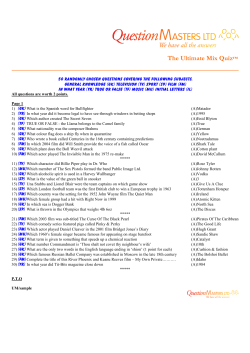
static charge measurements using keithley equipment
II I. 2, / 1, : :. Model Keithley Inrtruments, Inc. 2877s Aurora Road/Cleveland, Ohio 44139/U.S.A. (216) 248GkWTelex: 98-5469 .j, ,I ‘, ,, :‘r:i,: ., ‘+ i,.’ I 2501 and Model 2503 Product Notes May 3, 1982 Rev. B STATICCHARGEMEASUREMENTS USINGKEITHLEYEQUIPMENT INTRODUCTION EleCCrOstetlC charge is a deficiency or exce*s Of electrons on en ungrounded surface. Charges ere readily acquired o” poor conductors of electricity (such as plastics, synthetic fibers, fabrics, paper, and hydrocarbon salids and liquids) during handling and industrial processing of these materials due to friction with themselves, other materials, or machine parts. The effect of static potentials is depicted in Figure Once acquired, the charges are not easily dissiiced because of the law conductivity of the materia FIGUKE A EFFECT OF STATlO POTENTIALS The annoyances and hazards of such static charges have long bee” familiar to the plastics, paper, printing, and textile industries, and to those working with explosives, inflemnable liquids, or working in explosive Electrostatic f”rces cB”se dust or vapor atmospheres. the attraction of d,,st and dirt, and cause self-attraction of the charged material, which makes it difficult to operate fabric looms, stack plastic bags, handle webs of plastic or paper, and many others. The co”sequences of electrostatic spark discharges range from the annoyance of personal shocks to a” explosion in a factory, arsenal, gtai” elevator, or gasoline tanker. The Keithley gtatic Charge measuring systems consist of the Static Detector Model 2501 or 2503, which is held “ear rhe surface to be measured, a” inter-connecting low noise cable far the Model 2501, and a Keithley Electrometer, used as a high impedance voltmeter, which is calibrated to read the surface potential “ear the Detector. The Model 2501 measures static volts to 30K” and the Model 2503 measures static volts fo 15K”. Static voltages up to one megavolt ca” possibly be measured Document Number 32426 with the Model 2501 and appropriate Electrometer, provided the system is recalibrated. That is, the Detector Head must be far enough away from the charged surface to avoid corona discharge to the Head end input cable length should be shortened. GENERATION OF ELECTROSTATICS It is necessary to study quantitatively the location and intensity of accumulered charges. The Keifhley Model 250, or 2503 Static Detectors (described tn Figures B and C) and a” appropriate Keithley Electrometer are reliable, self-contained measuring systems designed for measuring electrostatic charges a” webs Of plastic, laminates, paper, or any relatively flat surface where static charges are distributed. MODEL 2501 STATIC DETECTOR HEAD is 3” in diameter and comes with a 10 foot IC gives a voltage divFsio” ratio cable. of 10,OOO:l AlO% when held 3/g” away from e charged plane at least 3” in diameter. “any static problems are encountered with stationery Plastic begs clinging together films or laminates. into this category. or repelling each other would fall A potential may be induced o” the film or laminate for meesuring the leakage time by either of two methods. In the f,.rsL method, the charge is induced on the film by manual rubbing contact between the stationary film or laminate and a rapidly moving cloth or tissue. This method is difficult to standardize and would also tend to remove surface coatings of anti-static agents. 1ts main virtues ere simplicity and speed. ‘rhe second method of producing a static charge o” the film or laminate is to bring it “ear a” assembly of needlepoints charged to a high dc potential of from The potential is set t” a known 10 IX 50 kilovolts. value end the film or laminate becomes charged bv the ionized air quantitative ecialized and by induction. This method is more then the first but requires cbe use of equipment. When the charged film “r laminate comes “ear e charged surface of the same polarity, a repulsive eleccroacatic force will result. This force could be of sufficient strength t” ceuse the fFlm to fly eway from e machine part or to fly away from lower film layers during windstacking of begs made from UP. Under such conditions, plastic film could become difficult. Static charges on plastic film will induce charges of opposite polarity o” nearby ungrounded (electrically neutral) machine parts. The resultant electrostetic field will set up attractive forces between the film and the machinery. The intensity of the electrostatic field will depend upon the distance seperating the machine part from the film and the magnitude of the charges on the plastic film. This field may be strong enough to cause sticking or janming of the film in e processing machine. Methods of computing these forces will be found F” the section entitled “Qusntitative Evaluation”. The Keithley Static Charge measuring systeme are designed to measure the static voltage on flat surfaces for evaluating the reduction of charge buildup. MODEL 2503 STATIC DETECTOR PROBE Solid coaxial tube l/2” in diameter, co”sisting of a 3 l/2” heed, 3 l/2” coupler, 1” sdapter, and two 90” sngle adaprers which may be placed enywhere along the probe. It gives e 10,000: 1 NO% voltage division ratio whe” held l/4” away from e charged plane et least l/2” in diameter. Typical surfaces of interest ere sheets of psper or plastic when being used in processing. packaging or When acetic electricity prabconverting equipment. lems ere suspected, measurements can be made on the plastic webs or substrates es they move through the machinery. The meesurements should be made acro(~s the entire width of the web or substrate and a” average value recorded. Measurements et ~onee~t. points would be made only to essess the explosion hazard of the electrostatic charges in an inflammable atmosphere. APPLICATIONS THE EFFECTS OF STATIC ELECTRICITY If the static charge of stacking end wind-up operations of the web or substrate is to be determined, the measurements should be made six inches before the wind-up or stack es well es on the wound-up roll or the stack. The measurements should again be made ecross the entire width of the web or substrate and en everage value recorded. These procedures will provide a picture of the charge intensity before entering the roll or stack and on the roll or stack. Calculating the effect of static charges on the machinery will be discussed later. Dust end dirt will be attracted to moving or stationary plastic films or laminates which possess electrostatic charges. Thus anti-stetic measures must be used until e method is found which will reduce the potential on the film or laminate under the severest of stetic generating conditions. Electrostatic charges ten cease spark discharges of sufficient energy levels to ceuse explasions in B” inflammable atmosphere. The minimum voltage necessary for ignition may be 200 volts between close “eedlepoints and 2,500 volts for e discharge between spheres l/2” apart. After the static problem is deffned, the effectiveness of anti-seatic measures ce” be evelueted. St*tif meesurements should be made on the most convenient and represenrative area of the film or sheet in the processing equipment. The measuring system should be placed et the eeme spot on each rest run. so that the factors which effect the formation of static will be kept the sate for each test run. Comparison runs with e” snti-static measure and the control run should be made on the seme day so that temperature end humidtty, which affect static so much, will have the eeme effect on the static buildup on the different film samples. The static charge acquired muet be measured immediately after charging in either cese co have meaningful resuits. For e give” capacity between parallel plates, the energy of the charge is proportional to the square of the voltage. (For example, the electrosraric energy of a plastic film charged to 1,000 volts is about 1,500 ergs or 0.00015 joule; if the potential of the plastic film is raised to 10,000 volts, then the energy rises to 150,000 ergs or 0.015 jwle.) If the use of a” anti-static measure reduces the voltage on the film or laminate to one-tenth of ifs former value, the” the energy of the spark will be reduced to one-hundredth. If the minimum electrostatic Potential in volts required to ignite a particular explosive gas is know”. the Keithley Static Charge measuring system may be used to deter”,ine whether a dangerous situation exists. Anti-static measures can the” be evaluated es previously described. Since the maximum ecquirable potential of films and laminates and the leakage rate of the charge is depen-2- dent on the relative irumidity and temperaeure of the surrounding atmosphere, tbeee meaeurements should be carried out under controlled humidity and temperature conditions. It is generally preferable to take readings on the underside of a film or sheet since this side has us”ally been in more intimate contact with the machine parts. The Static Detector should be kept away from the edge of the film because the electrostatic field intcneity will be distorted in this area. The static charges measured in a machine o” moving film will vary slightly in intensity from point to paint, and the average or most consistent reading should be used for calculations but both high and low peake should also be reported. The electrostatic propertiee of Stationary films or laminates can be aasessed and eriti-static measures evaluated by making t”o static meaeuremente. The first measurement serves to determine the maximum pofential or voltage that the film or laminaee ca”.acquire. the second meas”reme”t, made at the same time as the first, determines the rate at which the charge leaks away. The charge leakage may be defined as the rime in eecends required for the charge to fall to one-half of its original value. A plastic film or laminate can be considered “on-static when the leakage time falls below l/2 second. THE ElLMINATION OF STATIC CHARGE The most cormonly used method for removing: saatic on film or laminates is the discharge of the static by a conducting metal connection to ground. For example, grounded tineel or brushes rubbing the charged surface are cormonly used. Conductive discharge will have limited effectiveness. Only the charges picked up by the metal at the friction Conductive discharge is ueepoints will be removed. ful because it prevents any spark discharge which might coneritute a sefety hazard. Although air is one of the poorest electrical conductors, its conductivity can be markedly improved by If the air poaaesees increasing it6 molecure content. sufficient condwti~i~y, the charges on the film thread or fiber surface will drain away rapidly. Also, when the moisture content of the air is raised, a thin layer of moisture may be depoeited on the film thread or I” certain fiber surface, making it more conductive. cases, the application of Steam has bee” reconnnended. static neutralizers supply ionized air between the grounded neutralizer end rhe charged film or laminate. ‘rhe iontzed air particles are drawn o”t of the air and neutralize all or pert of the opposite charges residing an the film. There are three mai” types Of 8LBLiC netitralizers in use: high voltage, induction, end radioactive. A high voltage neutralizer applies a high voltage to needlepoinrs placed along rhe neutralizer bar. These needles do not contace the plaetic web. A” alternating current of 5,000 to 15,000 volts is supplied to the needles from a conductor in the center of the bar. The other terminal of the transformer euPPlYi*g the high voltage connects to ground. field surrounding the needlepoints ionizes the surrounding air. The electrostatic is Lhe force which An induction neutralizer oees grounded wire bristles or tinsel, which do not touch the film surface, and which are fastened along metallic or wooden support The needles of theee neutralizers acquire e b***. charge by inducrio” from the electrostaric field bet.,,een them and the electrostatically charged surface. The electric field surrounding the needlepoints is the The differforce which ionizes the surrounding air. ence between these neutralizers and high voltage “euWith tralizers is the method of charging the needles. induction neutralizers, the higher the charge on the surface, the greater will be the ionization of the surrounding air. A radioactive neutralizer generally ueee either radium Here, alpha partior polonium for ionizing the air. cles are emitted from the disintegrating nuclei of radium, polonium, or other radioactive isotopes and strike the air particles, ionizing them. The ionizing range of alpha emission in air is limited to e” effectivc dietance of about three inches. The basic requirement for a” e”ti-static agent 18 that if should prevent the accumulation of static charges end leek them away rspidly when present. Many antistatic agents ere selected primarily to leek static charges from the film surface. They are effective because they increase the electrical conductivity of the film surface, either by increasing the concentration of water on the surface through hygroscopic addition, or by splitting into ions. Other anti-static agents rely on lubricating effects in order to prevent the generation of the cherges through friction. Many agents Possess both conductive 1t is generally believed end lubricating qualities. that egente which have lubricating qualities or conductive and lubricating qualities are the most useful on moving plastics. I” order should: 1. 2. 3. 4. to be comnercinlly useful en anti-static Se unaffected by normal handling. Not affect the physical properties of the film or laminate adversely. Se relatively permanent. Be low in cost, safe to handle and if the application warrants, approved by the Food and Drug Adminietracio”. Numerous chemicals have bee” proposed as anti-stetic films or laminates, but most belong agents for plastic four classes: to one or the other of the following I. 2. 3. 4. ~itroge” compounds, aucb ee long-chsi” amines, amides, end quaternary bases. Sulphonic acids and sulohonates, such as sodium alkyl benzene sulphonate. Polyglycols end their derivatives, including polyglycol esters of fatty acids and polYglycol aryl or alkyl ethers. Polyhydric alcohols end their derivatives, qs, for example, sorbieol laurate. OPERATION SUMMARY connectthe Model2501or 2503Detector to the Keithley electrometer, and connect a ground wire from the Electrmneter case to a good external ground point (see figure D). Turn the Electrometer to the proper sensitivity. j,ODEL 2501 OPERATION ,.,ith the slide all the way into the Detector Head, press the INPUT SHORT button and set the Electrometer zero. Release the INPUT SHORT button. QUANTITATIVE EVALUATIONS The Keithley eeasuring *yetem mea*ure* the voltage of It measure* valtthe surface to which it is exposed. age in Cead of coulombs, coulombs per cm’, or electrons per cm3 because it is possible to build a voltmeter with the special features needed for the task, while direct meas”rementa of charge and/or charge density I,, measuring and in evalare much more cumbersome. uating the data obtained with the Keithley system it is neceseary to keep in mind the cancepc that voltage is measured directly and charge and charge density are position the detector Head 3/S inch from the surface being measured, pull the slide ““t, and read the potential of the surface being measured. A,, alternative diately after info posie~ion method is to withdraw the slide irnmezeroing, and then move the Detector Head while maintaining ehe 318 inch distance. Reliable results are obtained if the reading is made within about fifteen seconds after removing the slide and if the meter is not driven off scale while moving the cup into position. The exposed target electrode in the Detectm Head m”st not be touched. &Q&&L 2503 OPERATION set. the Electrometer zero check BWLtCh. Disengage the Detector measured, zero by engaging the Electrometer .the Electrometer zero check switch, Probe l/4 tnch from the surface end read the static potential. The Detector-to-charged surface spacing tained accurately to within *l/32 inch, voltage measurements can readily occur. position being m”sL be mainor errors in FIGURE D Schematic Representation of Keichley Static Detection System with a Model 2501 Static Detection Heed In computing charge and charge density, further inaccuracies enter because the area of charged surface affecting the target of ehe ~ecector is not sharply defined. Figure D shows the Keithley 2501 Detector Head and Electrometer measuring a charged surface, giving the significant electrical parameters. The Static ~etecLO= Head consists of B spun aluminum cup, holding a target electrode on a teflon insulator, The Detecting Head also has a Slide, which is at ground potential, a8 is the Conical Shield. When it is pushed into the Shield, it places the Target in a volume which Fe free of electrical fields. The input Short switch connects the Target to ground potential, when operated. Further, voltage of the charged surface after the Detector has been removed depends upon many capaciSo, here tances which cannot be readily evaluated. again, the actual value cannot be known to the acc”8tamed accuracy for physical meas”rements. The Keithley Static ~etecrors are carefully designed so that the ~ececeor target can be completely enclosed and brought to ground potential during zeroing. When that Fs done, the complete change from zero LO the “nknown potential is applied BC~DBB cspacieance Cl, as described in Figure D. When the Electrometer ia zeroed without the Model 2501 slide in place, the measurement will be the potential difference between the desired unknown surface and some unknown arbitrary potential affecting the detector target when the Electrometer Was being zeroed. Cl ta the capacbmce between the charged ~“rface and the Target. C3 is the capacitance from the charged surface Co the Conical Shield and rhe Target, wieh the Target connected to the Shield. C2 is the total capacitance to ground of the Target, the connecting cable Hi conductor, and the inp”e circuit of the Meter. The Meter is an Electrometer Voltmeter which has a” input resistance greater than 1014 ohms. It* purpose is to measure the voltage of capacitor C2. There is no si&ficant charging of C2 by the Electrometer during the time meaaorements are being made. Rezero fhe Electrometer when changing ranges and between readings. And remember to observe correct Detector-to-charged surface distances. Also, the Keithley Electrometer must be used on the VOLTS position. -4. Assume 5000 square inches is the total sheer which is carrying charge through difference. The total charge is: Quantitatively: clE1=C2E2 where El is the potential SC~OBB Cl and E2 is the potential *cro88 C2. Since charge can be defined 8s Q=CE, then the charge on Cl and C2 is C2 is principally cable capacitance and is equal. constant since a fixed length of cable is used. q = 8.4 x 10-9 Inserting values in (3) x 5000 (sq. in.) gives: w = 6.3 joule8 Cl is determined by the dimensione of the Target, the Conical Shield, and the distance from the charged surface to the Detecting Head and is chosen to give adequate sensitivity and a Head size con;gn;;;t to use. E2 is El/lO,OOO and Cl is C2/ 2 . If thFs work wsa accomplished in one-tenth second, 63 This is an appreciable amo”nt watts would be required. of power to be transferred from the mechanical syetem and put into the electrical system. Such a power level indicares that ststlc electricity generation requires eubstancisl consideration in the design of equipment handling chargeable materials, in the design of static removing equipment, and in the desirability of finding some mesns to prevent the generation of static electricity in the first place. Knowing the voltage of the charged surface, the total charge in the area affecting the target 1s determined by Q coulombs Q = C3E1 (1) C farads E volts When the Head is withdrawn from the charged surface, which is presumed to be an excellent insulator, there 18 no addition or reduction of charge. But the capscitsnce of the surface to ground~ls reduced considerably, depending on how msny other conductors st ground pqrential sre in the imediate vicinity unless the charged surface is large enough that the change in capacity is negligible. with the Detector Head 3/S inch from the charged surface, the area inside the cone, which is the part that affects the target, has a capacitance C3 of about 2 micro-microfarads to the grounded surfaces. Assume the surface potentisl El was measured to be 5000 volts. If the charged surface were backed by a ground plane, then the effective value of c3 and the stored energy would be much grester. Solving (1) : Q = 2 x 10-12 (farad) Q = 10-S coulombs these (coulombs/in2) sres of the the potential From equation is -->..^^_I x 5 x 103 (volts) (1) El = &; thus, El increases 88 C3 The diameter of the surface inaide the cone is 3 inches; the area is therefore 7.1 square inches. With a tocal char%= of 10-S coulombs, the charge coulombs per square inch. sity is 1.4 x 10 charge density as measured Head is expressed: aEm AREA 2.8 x 10-13 El by the Model 2501 Detector FIGURE E MODEL 2503 STATIC DETECTOR PROBE TIP Partial curaway ahowing internal con~truction and probe target area. Drawing does not show the coupler or adapters that make up the probe assembly. coulombs/in2 The energy expended in moving tial gradient is expressed: w W Q E den- charge through = l/2 QE is work in joules is the total charge, in coulombs is the potential difference through charges are moved s poten- (3) which The voltage of a surface which has been measured with the ElectromeLer, because of the reduction in C3 as the head is withdrawn, ranges from about twice the reading on the meter down to exactly chat read by the meter depending upon the mobility of the charges on the surface and upon the change of capacitance of the surface ss it is being measured end as it is being used. the Q is obtained by taking the charge density on a web or sheer of plastic or paper as computed above, then multiplying it by the area that is affected by the processing machine. Conducting surfaces attached to a low impedance so”rce of voltage, such 88 a battery or rectifier power supply, however, gain and lose charge as the externsl capacitances at their outputs change. Thus, their potentials are not affected by the DetecCing Head. E is the voltage difference, and can be from zero (assuming that no charge existed on a reel of plastic before it we unwound) to the El read by the Electrometer (assuming that the voltage was measured on the web within a short distance from where it parted from If El was measured at 30,000 volts, the the rollJ. charge density would be: Charge Density = 2.8 X 10-l’ ~1 (co”lom;s/in2) = S,4 x lo-9coulombslin Greater sensitivFty and/or decreasing (4) -5- can be obtained C2. by increastng Cl Cl is determined by the Target area and its spacing 'from the charged surface. This is determined by the dimensions of the Conical Shield and is difficult to modify without extensive machining. A new Detecting Head could, of course, be fashioned by the user to meet his specific requircmencs. C2 is principally the capacirance of the connecting cable, and will be reduced directly as the length of the cable is reduced. Eliminating the cable altogether produces a substantial increase in seositivity, but makes the instrument physically awkward to use. The Model 2503 Static Detector Probe may be evaluated quantitatively as is the Model 2501. Figure E is a cutaway sketch of rhe Model 2503 showing interior details. Contact your Keithley description sod price Keithley Electrometers Sales Represenrative for a full of each of the complete lFne of and both Static Detectors. If, in addition to static charge measurements you also wish to investigate other material phenomena such as charge dissipation, consider the Keithley Volume and Surface Resistiviey system which is comprised of our Model 6105 Kesistivity Adapter, Model 6lOC Elecfrometer, end Model 240A High VoltsgpSPower Supply. ohms and volume Surface resistivieies of up tp,lO ohm-cm cm be readily resistivities of up to 3 x 10 measured with this Keitbley system which is in accord with the ASTM Standard Method of Test D257-66 for Electrical Resistance of Insulating Maeerials. For further information see the Keiehley Product Notes entitled "Results and Techniques of Volume and Surface kesisfivity Measurements Using Keithley Instruments".
© Copyright 2025









